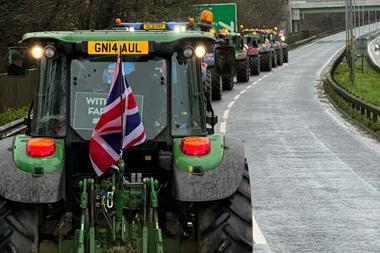Hoped for rebound in breeding and slaughter numbers stymied
Foot and mouth disease confirmed by MAFF in southern England on Tuesday is the latest and potentially the most devastating in a series of livestock illness outbreaks disrupting UK pork and bacon.
Swine fever outbreaks which began in Essex last August prompted official action to restrict pig movement and slaughterings.
This further squeezed supply to processors already suffering shortages as a consequence of breeding herd contraction after a market crisis wiped out producers' net incomes in 1998-99.
More recently it has become clear two other diseases, PMWS and PDNS, are causing serious loss of productivity in pig units across much of England.
These illnesses had been present in herds well before the swine fever epidemic, but at first attracted little attention outside the farming community. Like swine fever, they were first identified in East Anglia but began appearing in herds from Yorkshire to southern England by the middle of last year. Although not threats to public health, these ailments hit productivity by causing high weaner mortality and halting finishing pigs' growth.
Their main significance to the processing and retailing sectors is in delaying or preventing the hoped for rebound in breeding and slaughter pig numbers after the sharp decline last year.
"Whilst disease factors continue to bring pressure to bear on the industry, there is little likelihood of any expansion in numbers," according to the MLC, which during the last few months has repeatedly revised downwards its forecasts of UK slaughterings and pigmeat production.
Current slaughterings of around 220,000 head weekly are about 20% lower than a year ago, and the MLC's latest prediction is for a first quarter kill down 13% from January-March 2000.
A year-on-year increase in production is seen as probable in the third or fourth quarter this year, but any uptrend will be nowhere near enough to transform the fortunes of the hard-pressed pig slaughtering sector.
{{M/E MEAT }}
Close menu
- Home
- Retail & Wholesale
-
Products & Suppliers
- Back to parent navigation item
- Products & Suppliers
-
Product Categories:
- Back to parent navigation item
- Product Categories:
- Alcoholic drinks
- Bakery
- Cereals & breakfast
- Cheese
- Chicken & poultry
- Chocolate
- Confectionery
- Crisps, nuts & snacks
- Dairy
- Fish
- Fresh produce
- Frozen
- Household
- Meat
- Own Label
- Sauces & condiments
- Seasonal
- Soft drinks
- Vaping
- Vegan & plant-based
- World foods
- Suppliers
- People
- Reports & Data
-
Topics A-Z
- Back to parent navigation item
- Topics A-Z
-
Popular topics:
- Back to parent navigation item
- Popular topics:
- Cost of living crisis
- Crime
- Deposit Return Schemes
- Finance
- Government & Regulation
- Health
- Inflation
- Loyalty
- Marketing
- Mergers & Acquisitions
- New Product Development
- Sourcing
- Supply chain
- Sustainability & environment
- Technology
- Ultra Processed Foods
- Vaping
- A-Z all topics
- Content by type:
- Events
- Subscribe now
Sign in to comment on this article
Not logged in before? Register for FREE guest access today.
You will be able to:
- Read more stories
- Receive daily newsletters
- Comment on stories
Advert


















No comments yet